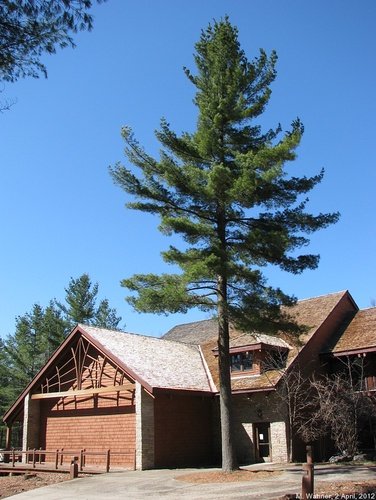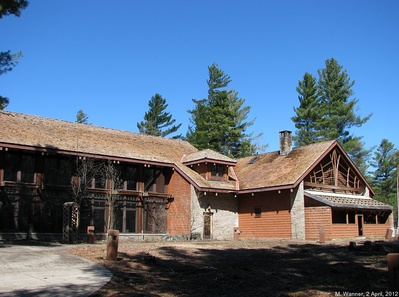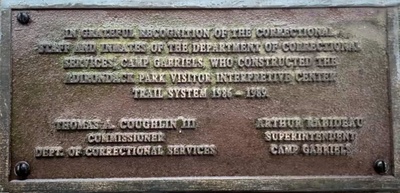 The Paul Smiths Adirondack Park Visitor Interpretive Center, Heron Marsh from the Barnum Brook Trail
The Paul Smiths Adirondack Park Visitor Interpretive Center, Heron Marsh from the Barnum Brook Trail  The Paul Smiths Adirondack Park Visitor Interpretive Center
The Paul Smiths Adirondack Park Visitor Interpretive Center  The Paul Smiths College Adirondack Park Visitor Interpretive Center There were two Visitor Interpretive Centers in the Adirondack Park, one in Newcomb and one in Paul Smiths. They were built in the 1980s by the Adirondack Park Agency on land belonging to SUNY ESF and Paul Smiths College, respectively, to help visitors understand the Adirondack Park.
The Paul Smiths College Adirondack Park Visitor Interpretive Center There were two Visitor Interpretive Centers in the Adirondack Park, one in Newcomb and one in Paul Smiths. They were built in the 1980s by the Adirondack Park Agency on land belonging to SUNY ESF and Paul Smiths College, respectively, to help visitors understand the Adirondack Park.
The state relinquished responsibility for both VICs at the end of 2010 to the two educational institutions. The trails at Paul Smith's have been re-opened to the public, and a director has been hired who is working to put the Paul Smith's VIC on a self-sustaining basis as a community facility.
Adirondack Daily Enterprise, April 12, 1985
Six Tri-Lakes sites seek Visitors Center
By SHAWN TOOLEY
RAY BROOK — Fifty-one sites in 30 townships are being considered as the possible location of the Adirondack Park Visitors Interpretive Center, including six in the Tri-Lakes area.
 A plaque recognizing the work of the inmates at Camp Gabriels in building the trails at the VICThe Adirondack Park Agency Thursday released the names of the towns competing for the $2 million tourist information center, which is expected to attract some 100,000 visitors each year.
A plaque recognizing the work of the inmates at Camp Gabriels in building the trails at the VICThe Adirondack Park Agency Thursday released the names of the towns competing for the $2 million tourist information center, which is expected to attract some 100,000 visitors each year.
Sites that have been in the running for several months have been joined on the list by a number of newcomers and relative unknowns. Agency spokeswoman Laura Viscome says proposals were received from towns, villages, chambers of commerce, industrial development agencies and private landowners.
Harrietstown's previously announced proposal to place the center at the Department of Environmental Conservation's education and conference center on Lake Colby has been joined by two other candidates.
The Ampersand Bay resort complex on Lower Saranac Lake has been submitted for consideration by owner Walter Emmons of Saranac Lake. Viscome says the other suggestion is for a lot on Oseetah Lake which she could not identify.
In Tupper Lake, where the school board and Chamber of Commerce are backing a proposal to build the center for the state on a scenic lot behind L.P. Quinn Elementary School, Agency officials are also perusing a proposal to situate the center on village owned land around the Municipal Park on Raquette Pond.
Agency officials examined the Municipal Park area earlier, before the avalanche of formal proposals began.
The Department of Environmental Conservation's Meadowbrook Campground off Route 86 in Ray Brook in North Elba has also been proposed, but by whom remains a mystery. The town board has not taken sides in the matter. "The town board went on record as not recommending any site ... but we do support the concept," North Elba Supervisor Matt Clark said today.
An EnCon official could not say for sure today if his department suggested the site, although he said it was doubtful.
Other area sites in consideration include one near Paul Smiths in the Town of Brighton, near Onchiota in the Town of Franklin and near Whiteface Mountain Ski Center in the Town of Wilmington.
The full list, with each town's name and the number of proposals in parentheses, follows: Ausable, Brighton, Chestertown (3), Crown Point, Elizabethtown (2), Ellenburg, Fine (2), Franklin, Harrietstown (3), Horicon (2), Indian Lake (2) Ausable Forks (3) and Keene.
Also, Keeseville (2), Lake George, Long Lake (4), Minerva, Newcomb (2), North Elba, North Hudson (2), Peru, Saranac (2), Schroon, Speculator, Ticonderoga (2), Altamont (2), Warrensburg (3), Westport (2) and Wilmington.
The site proposals range in size from one to more than 500 acres.
With $200,000 included in the new state budget to study the proposals, the Park Agency will hire a consulting firm to produce a general environmental impact statement on the center. The statement will be used, Viscome said, "to reduce (the number of proposals) drastically, perhaps to as few as two or three."
Public comment and opinions on the site selection will be taken after the impact statement is completed, sometime in June. This changes the timetable outlined at a recent Agency meeting, where a staffer told commissioners the final candidate list would be ready in May.
Viscome said the delay is probably due to the great number of site proposals. Gov. Mario Cuomo has said he will make the final selection within days of being presented a final Agency list. but the Agency now says that decision will be made in consultation with the legislative leadership.
Adirondack Daily Enterprise, May 19, 1989
Sportsmen fear irretrievable loss of cultural heritage
Dear Editor:
Many area residents have approached me about the sportsman's demonstration scheduled for next Wednesday, May 24, at the Governor's opening of the Visitor Interpretive Center at Paul Smiths. 'What are the issues?" they ask. I hope this letter can, in some small way explain the answer.
The focus of VIC is supposed to be natural history. The natural history of the Adirondacks for the last 1000 years had been affected by man and I suspect will continue to be affected by him in the future. Hunting, fishing and trapping was a means of survival to our parents, grandparents and continues to be a part of our life. We still share our venison with our friends and invite cold neighbors to our ice shanties for a warm cup of coffee.
Most of the Adirondack Park commissioners and upper management officials of the Visitor Center are recent migrants to the Adirondacks. They view hunting, fishing and trapping as recreational pursuits much like tennis and golf, although with a much more critical view because of the consumptive nature of these activities. They view these activities as controversial and from their resource base, they indeed may be right. However, the controversy is in the eye of the beholder. The vast majority of Adirondack residents do not view these activities as controversial. In fact, most of us see them as more than just sports such as tennis and golf. We have made hunting and fishing an intricate part of our way of life.
Hunting, fishing and trapping has been weaved into our family relationships, conservation efforts, traditional rites, speech patterns and economic subsistence. We talk about when "Suzy" caught her first fish and when "Joey" was old enough to go to deer camp with the men as being cherished rites of passage into adulthood, not as controversy. When an anthropologist studies a tribe he might know their language and record the practices of the people but still not understand the true significance of the meanings of these activities. The analogy works well in this instance. The State of New York has funded with tax dollars of the people a study of the Adirondacks and has sent in its experts to interpret our story to the rest of the world through the establishment of the Visitor Interpretive Center. Although these people are knowledgeable experts and speak our language and record our customs, they view us from the perspective of non-Adirondack backgrounds. Thus they make the mistake of not seeing hunting, fishing and trapping as a significant part of our life style but treat it as merely a sport that we participate in.
When visitors come to the VIC to interpret us, they must understand how these activities are so much a part of our lives that they have had a profound effect on the natural history of this area. If these truths are not adequately portrayed then visitors won't understand who we really are. What I fear most, however, is not that others won't understand us but as we visit the center we may lose our own cultural heritage because the "mirror" we see does not reflect a true image. You and I might know that the "reflection" is not genuine, but our children won't remember a different image in the Visitor Center "looking glass."
When our children don't remember, we will have lost our cultural heritage as people living as a part of the balance of nature. In a generation or two we will no longer be a part of the natural history of the Adirondacks but just another reaction to it. When Joey doesn't go to camp and Suzy doesn't want to fish and neither can remember why anyone would want to do those kinds of things, it will be a sad day for all of us.
Perhaps now you can see why sportsmen are so sincere about the story that's to be told at the VIC and why we must be heard. If we express how we feel by letters, phone calls or even a picket line, perhaps we won't lose our heritage and neither will you.
Sincerely, Robert E. Brown
Snowshoe Lodge Saranac Lake
External links:



